The Manufacturer\'s Ultimate Guide to Preventing Premature Crankshaft Failure & Boosting Engine Lifespan
In the intricate symphony of an internal combustion engine, few components bear as much critical responsibility as the crankshaft. It's the very heart that converts the engine's linear piston motion into rotational force, driving everything from the wheels of a vehicle to the blades of industrial machinery. To be honest, when a crankshaft fails prematurely, it's not just a minor inconvenience; it's often a catastrophic event, leading to extensive damage, costly repairs, and a significant blow to a product's reputation. For manufacturers, understanding and mitigating the risks of premature crankshaft failure isn't merely good practice; it's fundamental to ensuring product reliability and, by extension, boosting the overall lifespan of the engines they produce.
This guide delves into the multifaceted approach manufacturers must adopt to safeguard against this critical issue. We’ll explore everything from initial design considerations and material selection to precision manufacturing processes, rigorous quality control, and even the crucial role of post-manufacturing guidance for end-users. Our focus remains squarely on how a proactive, comprehensive strategy can prevent premature crankshaft failure and, consequently, dramatically extend engine lifespan, solidifying a manufacturer's standing in the market.
Understanding the Root Causes: Why Crankshafts Fail Prematurely and How Manufacturers Can Intervene
Before we can prevent premature crankshaft failure, it's paramount to understand *why* it happens. Interestingly enough, crankshaft failures are rarely due to a single isolated factor but rather a confluence of stresses, design limitations, material imperfections, or operational abuses. Many experts agree that the manufacturer's journey to boosting engine lifespan begins with a deep dive into these common failure modes, allowing for targeted preventative measures at every stage.
Fatigue Failure: The Silent Killer
Fatigue is arguably the most common culprit behind crankshaft failure. It occurs when the material is subjected to repeated cyclical stresses, even if those stresses are below the material's ultimate tensile strength. Over time, microscopic cracks initiate, typically at stress concentration points like fillet radii (the transition between the journal and the crank web), oil holes, or sharp corners. These cracks then propagate with each load cycle until the remaining cross-section can no longer bear the load, leading to sudden, brittle fracture. From a manufacturer's perspective, addressing fatigue means meticulous design to minimize stress risers and careful material selection to maximize fatigue strength.
Bearing-Related Issues: A Cascade of Problems
The crankshaft relies heavily on its main and connecting rod bearings for smooth, low-friction operation. Premature bearing wear or failure can directly lead to crankshaft damage. This can stem from inadequate lubrication (low oil pressure, wrong oil viscosity, contaminated oil), misalignment during assembly, excessive loads, or even manufacturing defects in the bearings themselves. When bearings fail, the crankshaft can experience metal-to-metal contact, overheating, scoring, and eventually, catastrophic failure due to excessive friction and localized stress. Preventing this means ensuring precise machining of bearing journals, proper bearing material selection, and clear lubrication specifications.
Material and Manufacturing Defects: The Hidden Flaws
Even with the best design, inherent material flaws or defects introduced during manufacturing can doom a crankshaft. This includes inclusions in the steel, improper heat treatment leading to incorrect hardness profiles, forging laps, or machining errors like chatter marks or incorrect surface finishes. These defects act as crack initiation sites, drastically reducing the component's fatigue life. In my experience, rigorous material quality checks and stringent process controls during forging, machining, and heat treatment are non-negotiable for preventing these hidden dangers and boosting engine lifespan.
Torsional Vibration and Resonances: The Engine's Own Enemy
Engines inherently produce torsional vibrations as power pulses are delivered to the crankshaft. If these vibrations coincide with the crankshaft's natural torsional resonant frequencies, the amplitudes can become extremely high, leading to rapid fatigue failure. This phenomenon is often mitigated by harmonic balancers (also known as torsional dampers) or by designing the crankshaft and engine system to avoid critical speeds. Manufacturers must perform detailed torsional vibration analysis during the design phase to ensure the crankshaft operates safely across its entire RPM range.
The Manufacturer's Blueprint: Design and Material Selection for Unrivaled Durability
The journey to preventing premature crankshaft failure and boosting engine lifespan begins long before any metal is cut – it starts on the drawing board. The choices made in design and material selection are foundational to a crankshaft's inherent strength and longevity.
Strategic Material Selection: The Foundation of Strength
The material chosen for a crankshaft is paramount. Common choices include forged steel alloys (like 4340, 5140, 1045) or cast iron (nodular or ductile iron). Forged steel offers superior strength, fatigue resistance, and toughness, making it ideal for high-performance or heavy-duty applications. Cast iron, while less strong, is more cost-effective and suitable for many production engines. The decision hinges on the engine's intended use, expected loads, and target lifespan. Our company invests heavily in metallurgical research to select alloys that offer the optimal balance of strength, machinability, and fatigue resistance for specific engine platforms.
Optimized Geometric Design: Minimizing Stress Concentrations
Design engineers play a crucial role in shaping the crankshaft's geometry to distribute stresses effectively. Key design elements include:
- Fillet Radii: The transition radii between journals and webs are critical. Larger, smoother radii significantly reduce stress concentration, thereby increasing fatigue life. Sharp corners are an absolute no-go.
- Oil Hole Design: Oil holes, necessary for lubrication, can be significant stress risers. Their location, size, and chamfering must be carefully designed to minimize their impact on fatigue strength.
- Counterweights: Properly designed and balanced counterweights reduce bending loads on the main bearings and help to balance the rotating mass, reducing overall engine vibration and stress on the crankshaft.
Advanced simulation tools, such as Finite Element Analysis (FEA), are indispensable here, allowing engineers to predict stress distributions and optimize designs virtually before physical prototyping.
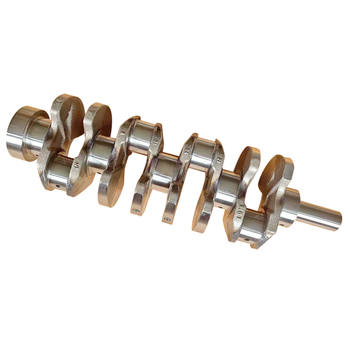
Surface Hardening and Treatment: Enhancing Wear and Fatigue Resistance
Even the strongest material can benefit from surface treatments that enhance specific properties. For crankshafts, surface hardening techniques are crucial for improving wear resistance on journals and increasing fatigue strength.
- Nitriding: A heat treatment process that diffuses nitrogen into the surface, creating a hard, wear-resistant layer and inducing compressive residual stresses that inhibit crack initiation.
- Induction Hardening: Uses electromagnetic induction to rapidly heat and quench specific areas (like journals), creating a hardened surface while leaving the core tough.
- Fillet Rolling/Shot Peening: Mechanical processes that induce compressive residual stresses in critical areas like fillet radii, significantly improving fatigue life by resisting crack propagation.
These treatments are vital for boosting the crankshaft's resilience against the relentless forces it endures, directly contributing to boosting engine lifespan.
Precision Manufacturing and Rigorous Quality Control: The Bedrock of Reliability
Even the most brilliant design and material selection can be undermined by flaws in manufacturing. This is where the manufacturer's commitment to precision and quality control becomes paramount in preventing premature crankshaft failure and boosting engine lifespan.
Machining Accuracy and Surface Finish: The Microscopic Details
The precision with which a crankshaft is machined is critical. Tolerances for journal diameters, roundness, taper, and alignment must be incredibly tight. Deviations can lead to uneven bearing loads, accelerated wear, and increased stress concentrations. Equally important is the surface finish of the journals. A smooth, controlled surface finish is essential for proper hydrodynamic lubrication between the crankshaft and bearings. Roughness can lead to metal-to-metal contact, premature wear, and even fatigue crack initiation. Our manufacturing facilities utilize state-of-the-art CNC machining centers and grinding equipment to achieve these exacting standards.
Dynamic Balancing: Eliminating Destructive Vibrations
A crankshaft, by its nature, is an eccentrically rotating mass. Imbalance can lead to significant vibrations, which not only cause noise and discomfort but also impose severe bending stresses on the crankshaft itself and the main bearings. Dynamic balancing, where the crankshaft is spun at high speeds and material is added or removed to achieve perfect balance, is a critical step. This process ensures smooth operation, reduces bearing loads, and significantly contributes to preventing fatigue failure and boosting engine lifespan.
Non-Destructive Testing (NDT): Uncovering Hidden Flaws
To ensure that no hidden defects escape the production line, comprehensive Non-Destructive Testing (NDT) is essential.
- Magnetic Particle Inspection (MPI): Used to detect surface and near-surface cracks in ferromagnetic materials.
- Ultrasonic Testing (UT): Can detect internal flaws like voids, inclusions, or internal cracks.
- Eddy Current Testing: Effective for detecting surface and subsurface flaws in conductive materials and verifying heat treatment depth.
These tests provide a crucial safety net, ensuring that only flawless crankshafts make it into our engines.
Assembly Procedures and Lubrication System Integration: The Final Touch
The way a crankshaft is integrated into the engine during assembly is as important as its individual manufacturing. Proper bearing installation, ensuring correct clearances and torque specifications, is vital. Any misalignment or overtightening can induce stresses or restrict oil flow, leading to rapid failure. Furthermore, the design and integration of the engine's lubrication system are paramount. Adequate oil supply, pressure, and filtration are critical for maintaining the hydrodynamic film that protects the crankshaft and bearings. Many experts agree that a robust lubrication system is the lifeblood of engine longevity.
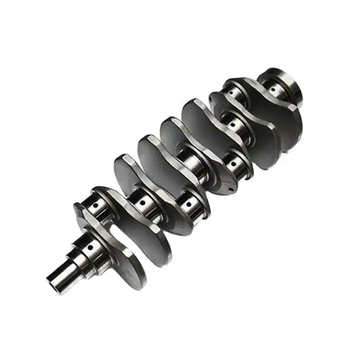
Post-Manufacturing Considerations: Empowering Users to Boost Engine Lifespan
While manufacturers lay the groundwork for preventing premature crankshaft failure, the ultimate lifespan of an engine also depends heavily on how it's used and maintained in the field. Providing clear, actionable guidance to end-users is a crucial, often overlooked, aspect of boosting engine lifespan.
The Critical Role of Lubrication: The Engine's Lifeline
Perhaps the single most important factor in preventing crankshaft failure post-manufacturing is proper lubrication. Manufacturers must provide explicit recommendations regarding:
- Oil Type and Viscosity: Specifying the correct oil grade (e.g., SAE 5W-30, 15W-40) and API service category ensures the oil can form an adequate protective film under all operating conditions.
- Oil Change Intervals: Clear guidelines on how often to change oil and filter are essential to prevent oil degradation and contamination, which can lead to bearing wear.
- Oil Level Maintenance: Emphasizing the importance of maintaining the correct oil level to ensure consistent oil pressure and flow to critical components.
A crankshaft starved of lubrication is a crankshaft destined for rapid, catastrophic failure.
Operational Guidelines: Driving Habits and Load Management
How an engine is operated directly impacts the stresses on its crankshaft. Manufacturers should educate users on:
- Avoiding Lugging: Operating an engine at low RPMs under high load (lugging) can induce severe torsional vibrations and high bearing loads, accelerating fatigue.
- Preventing Over-revving: Exceeding the engine's maximum RPM can lead to excessive inertia forces, potentially causing bearing damage or even crankshaft fracture.
- Proper Warm-up and Cool-down: Allowing an engine to reach operating temperature gradually ensures optimal oil flow and component clearances. Similarly, a brief cool-down period after heavy use helps dissipate heat.
These simple operational habits can significantly extend the life of the crankshaft and the entire engine.
Monitoring and Diagnostics: Early Warning Systems
For critical applications, recommending or integrating monitoring systems can provide early warnings of impending crankshaft issues. This includes:
- Oil Analysis: Regular analysis of engine oil can detect abnormal wear metals (indicating bearing or crankshaft wear), fuel dilution, or coolant contamination, allowing for proactive maintenance.
- Vibration Monitoring: Advanced systems can detect changes in engine vibration patterns that may indicate crankshaft imbalance or bearing issues.
- Pressure and Temperature Sensors: Monitoring oil pressure and temperature can alert operators to lubrication system problems before they become critical.
Providing avenues for early detection empowers users to intervene before minor issues escalate into catastrophic failures, thereby boosting engine lifespan.
Innovation and Future Trends: Pushing the Boundaries of Crankshaft Longevity
The pursuit of preventing premature crankshaft failure and boosting engine lifespan is an ongoing journey, driven by continuous innovation in materials science, manufacturing processes, and predictive technologies.
Advanced Materials and Manufacturing Processes
Research into new materials, such as advanced powder metallurgy alloys or even composite materials for specialized applications, promises crankshafts with even higher strength-to-weight ratios and improved fatigue resistance. Similarly, additive manufacturing (3D printing) is being explored for prototyping and potentially for producing complex geometries or specialized crankshafts with integrated features that were previously impossible. These advancements could redefine the limits of crankshaft durability.
Predictive Maintenance and IoT Integration
The rise of the Internet of Things (IoT) and advanced sensor technology is transforming engine maintenance. Future engines will likely feature more integrated sensors capable of real-time monitoring of crankshaft health, bearing condition, and lubrication system performance. This data, analyzed by AI-driven algorithms, can predict potential failures long before they occur, allowing for scheduled, proactive maintenance rather than reactive repairs. This shift from reactive to predictive maintenance is a game-changer for boosting engine lifespan.
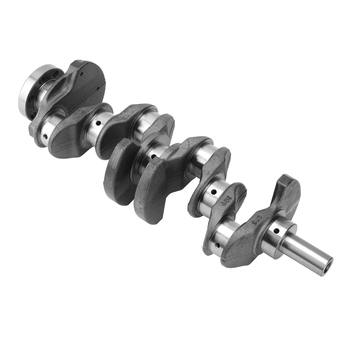
Digital Twin Technology and Simulation
The concept of a "digital twin" – a virtual replica of a physical engine – is gaining traction. This allows manufacturers to simulate various operating conditions, predict component wear, and even test design modifications in a virtual environment. For crankshafts, this means even more precise design optimization, better understanding of stress cycles, and the ability to foresee potential failure points under extreme conditions, further refining the ultimate guide to preventing premature crankshaft failure.
The manufacturer's role in preventing premature crankshaft failure and boosting engine lifespan is comprehensive, spanning the entire product lifecycle from initial concept to end-of-life support. It's a testament to meticulous engineering, rigorous quality control, and a commitment to educating the end-user. By embracing these principles, manufacturers can ensure their engines are not just powerful and efficient, but also exceptionally reliable and long-lasting, building a legacy of trust and performance.
For more detailed information, please visit our official website:Crankshaft failure prevention
About the author: Dr. Alistair Finch is a leading expert in advanced powertrain engineering with over two decades of experience in engine design, manufacturing, and failure analysis. Holding a Ph.D. in Mechanical Engineering, his work focuses on enhancing component durability and extending engine lifespan through innovative materials and precision manufacturing techniques. He frequently consults with global automotive and industrial manufacturers on critical reliability challenges.
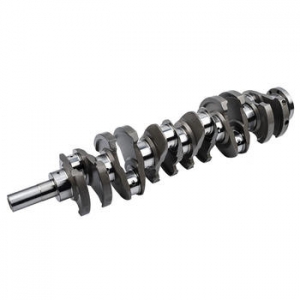 Trusted Crankshaft company Man
Trusted Crankshaft company Man
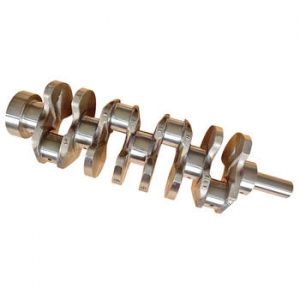 Professional Crankshaft Manufa
Professional Crankshaft Manufa
 Trusted Crankshaft Supplier: W
Trusted Crankshaft Supplier: W
 Trusted Crankshaft Manufacture
Trusted Crankshaft Manufacture
